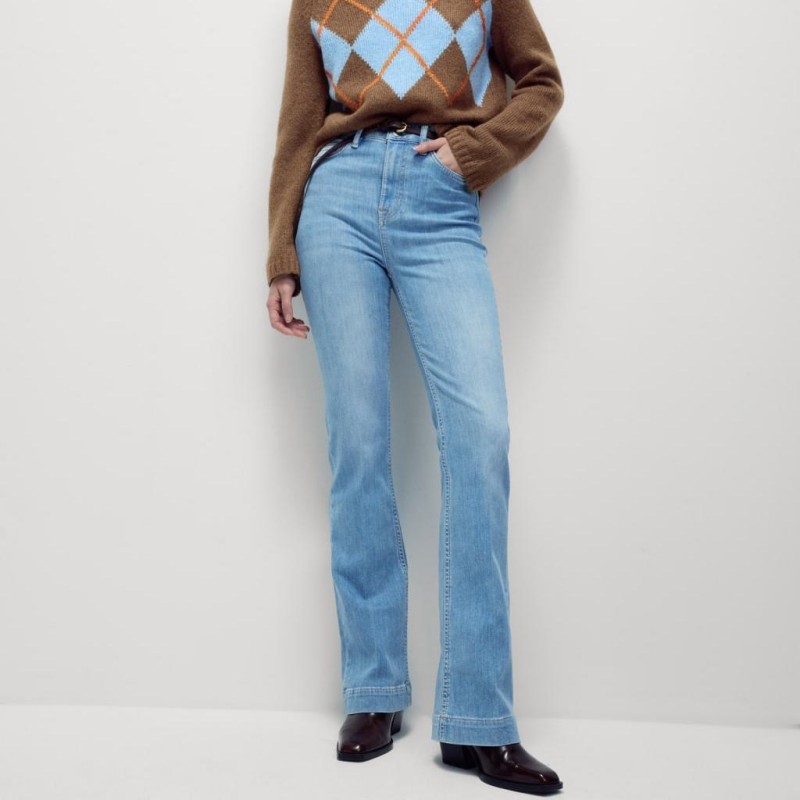Dyeing jeans is a fantastic way to revitalize an old pair or change their color entirely. It’s an engaging DIY project that allows you to personalize your clothing, enhance your wardrobe, and make a statement while being budget-friendly. Rather than discarding jeans that may have lost their luster or faded over time, dyeing can bring them back to life in a vibrant hue that matches your style. This article will guide you through everything you need to know about dyeing jeans—from the materials needed and various dye types to preparation and application steps, along with essential tips for achieving the best results. Whether you’re looking to transform a light pair into a deep indigo or want to experiment with tie-dye techniques, this comprehensive guide will provide the knowledge you need to successfully dye your jeans.

Contents
Understanding the Basics of Dyeing Fabric
Before diving into the specific process of how to dye jeans, it’s essential to understand the basics of dyeing fabric. Knowledge of dye properties, types, and techniques will help you achieve the perfect results.
Types of Fabric Dyes
- Fiber Reactive Dyes: These dyes are suitable for natural fibers such as cotton, flax, and rayon, making them ideal for denim. They bond well with the fabric and produce vibrant colors.
- All-Purpose Dyes: These versatile dyes can be used on multiple fabrics, including both natural and synthetic. However, they may not produce as vibrant of a color on natural fibers as fiber reactive dyes.
- Acid Dyes: Designed primarily for dyeing protein fibers, such as silk and wool, acid dyes can also be utilized on nylon. They require heat to set properly.
- Disperse Dyes: Mainly used for synthetic fabrics like polyester, disperse dyes are less common for denim if the primary goal is to dye cotton jeans.
Choosing the Right Dye for Your Jeans
When selecting a dye for your jeans, consider factors such as the fabric composition, the desired color, and the final effect. If your jeans are predominantly cotton, using fiber reactive dye will yield the best results. Conversely, all-purpose dyes work well if your jeans have synthetic fibers.
Understanding Color Theory
Before embarking on your dyeing project, it’s helpful to understand some basic principles of color theory. The final hue achieved when dyeing will depend on several factors, including:
- Fabric Color: The original color of the jeans will influence the final result. Darker fabrics often require more dye or multiple applications to achieve a light hue.
- Dye Color: The color of the dye itself plays a significant role. For example, dyeing blue jeans with a red dye will yield a purplish tone rather than a bright red.
- Mixing Colors: You can create unique shades by mixing different dye colors. Experimenting with combinations can lead to exciting results, making each dyed pair of jeans unique.
Understanding these principles will prepare you for the dyeing process, helping you achieve the desired outcome with your jeans.
Preparing to Dye Your Jeans
Preparation is critical for successfully dyeing jeans, as it ensures that you achieve the best results with minimal disappointment. Here are some crucial steps in the preparation phase:
Gather Your Materials
Before you begin, gather the necessary materials. Here’s a comprehensive list of what you’ll need:
- Dye: Choose your dye type based on the fabric content of your jeans.
- Plastic Gloves: These protect your skin from dye staining.
- Dust Mask: If working with powder dye, wearing a dust mask can help prevent inhalation.
- Plastic Container or Bucket: Use this for mixing dye and soaking your jeans.
- Stirring Stick or Spoon: For mixing the dye solution thoroughly.
- Water: Essential for the dyeing process. Follow the dye package instructions for the appropriate amount.
- Salt or Fixative: Necessary based on the dye type. Salt helps enhance dye fixation when working with fiber reactive or all-purpose dyes.
- Plastic Wrap or Trash Bags: To cover your work surface and prevent staining.

Choose a Work Area
Select a well-ventilated work area for dyeing your jeans. Ideally, choose a space that is easy to clean, as dye can cause permanent stains. Outdoor areas, such as patios, or well-ventilated garages, are excellent options.
Pre-Wash Your Jeans
Pre-washing your jeans is a crucial step. This process removes any finishes or coatings that may hinder the dye absorption. Wash the jeans in hot water and allow them to air dry slightly. They should be damp, which will help the dye adhere better.
Test for Compatibility
If you’re uncertain about how the dye will react with your jeans, consider conducting a test on a small, inconspicuous area or a scrap piece of fabric. This test allows you to evaluate how the dye blends with the fabric and whether you achieve the desired color.
Preparing adequately will set you up for success when dyeing your jeans. Consider taking your time during this phase to ensure that everything is in order before proceeding.
The Dyeing Process: Step-by-Step Instructions
Once you have prepared everything, it’s time to begin the dyeing process. Here’s a step-by-step guide to help you achieve your desired color effectively.
Mix the Dye Solution
- Follow the Instructions: Read the dye label carefully for specific instructions on how to mix the dye. Different dye brands and types may have varying requirements.
- Combine Water and Dye: In a plastic container or bucket, mix the appropriate amount of dye with hot water, as the heat will help dissolve the dye more effectively.
- Incorporate Salt or Fixatives: If using salt (for fiber reactive or all-purpose dyes), add the recommended amount to the dye solution to improve color retention.
Soak Your Jeans
- Submerge the Jeans: Gently place the damp jeans in the dye solution, ensuring they are fully submerged.
- Stir the Fabric: Use a stirring stick or spoon to agitate the jeans in the dye solution. This ensures even dye distribution. Continue stirring consistently for at least 10 to 30 minutes, or longer based on the dye instructions and the desired shade.
- Monitor the Color: Observe the jeans as they soak. Keep in mind that the dye will appear slightly darker when wet than it will when dry. Test the color by periodically removing the jeans and rinsing one section to see the final shade.
Rinsing and Washing
- Rinse the Jeans: Once the desired color is achieved, remove the jeans from the dye bath and rinse them in cold water to remove excess dye. Ensure that the water runs clear.
- Wash the Jeans: After rinsing, machine wash your jeans separately with soap in cold water to remove any residual dye. Avoid washing with other clothes to prevent color transfer.
Drying
- Air Dry: For the best results, hang your jeans to air dry or lay them flat. This method helps maintain shape and prevents shrinkage compared to using a dryer.
- Avoid Direct Sunlight: While drying, avoid direct sunlight, which could fade the color you’ve just achieved.
Post-Dye Care Tips
- Wash Separately: For the first few washes, continue to wash your newly dyed jeans separately to avoid color bleeding onto other garments.
- Use Color Catchers: To combat any residual dye, consider using color catchers in subsequent washes. They absorb any loose dye, helping maintain the vibrancy of your jeans.
Following these steps carefully will ensure you achieve rich and lasting color on your jeans, allowing you to enjoy them for many seasons.
Common Mistakes to Avoid
As with any DIY project, there are potential pitfalls that could derail your dyeing efforts. Here are some common mistakes to watch for and how to avoid them:
Skipping the Pre-Wash
Neglecting to pre-wash your jeans can lead to uneven dye absorption. Always ensure that you wash your jeans beforehand to prepare the fabric.
Not Mixing the Dye Thoroughly
Dye consistency is crucial for achieving an even color. Make sure to mix the dye solution thoroughly to prevent uneven spots or streaks in your finished jeans.
Dyeing in Cold Water
Using cold water for dyeing can significantly affect the result. Most dyes require hot water for effective bonding with the fabric. Always follow the dye manufacturer’s instructions regarding temperature.
Over-Dyeing or Under-Dyeing
Pay attention to the length of time your jeans spend in the dye bath. Over-dyeing can lead to overly dark or saturated colors, while under-dyeing may result in faded or imperfect shades. Follow the suggested times to achieve the desired result.
Ignoring Safety Precautions
Always wear gloves and work in a ventilated area during the dyeing process. Dye can stain skin and clothing, and strong fumes may be released depending on the chemicals used.
By avoiding these common mistakes, you will increase the chances of a successful dyeing project and achieve the results you desire.
Creative Techniques for Dyeing Jeans
Dyeing jeans doesn’t just have to mean changing their color; you can get creative with various techniques to achieve unique results. Here are some innovative dyeing methods for your jeans:
Tie-Dye Technique
- Create Patterns: For a vibrant, multicolored effect, try the traditional tie-dye method. Use rubber bands to fold and twist sections of your jeans before submerging them in different dye colors.
- Color Placement: Apply different dye colors strategically to achieve a funky, one-of-a-kind look.
Ombre Dyeing
- Soft Gradient Effect: For an elegant ombre effect, gradually dip your jeans into the dye bath. Start with the lower half in the dye for a specific duration, and slowly raise it, allowing the dye to blend upwards.
- Creating Depth: Rotate or twist the jeans to create interesting fading patterns and add depth to the color transition.
Splatter Dyeing
- Artistic Style: For an edgy artistic touch, use a splatter technique. Load a brush or sponge with dye and flick or splash it onto your jeans to create random patterns.
- Multiple Colors: Experiment with different colors and splatter placements for a unique effect that represents your style.
Reverse Dyeing
- Bleach Method: Utilize bleach to create patterns by applying it to dark jeans. Use a spray bottle or sponge to spot-bleach sections of the fabric. Rinse immediately for controlled effects.
- Control the Bleaching: The intensity of the bleach depends on the duration it is left on the fabric. Be mindful and experiment in small patches.
Patchwork Dyeing
- Dyeing Sections: Consider dyeing only certain sections of your jeans instead of the entire garment. This technique allows you to create unique patchwork effects and shows more of the original fabric.
- Combining Techniques: Feel free to mix and match different dyeing methods to produce a stunning visual effect.
Engaging with these creative techniques can elevate the typical dyeing process into a fun and artistic project, allowing you to personalize your denim like never before!

Conclusion
Dyeing jeans is a creative and rewarding endeavor that allows for personal expression and practical wardrobe enhancement. By learning how to dye jeans effectively, you can revive your old denim, experiment with colors, and truly make your clothing your own.
This comprehensive guide has walked you through everything you need to know, from selecting the right dye and preparing your jeans to executing different techniques and common pitfalls to avoid. Remember that preparation and attention to detail are key components to achieving vibrant and durable results.
As trends evolve and individual styles flourish, the ability to customize your wardrobe becomes ever more valuable. Embracing the DIY approach encourages a sense of uniqueness, allowing you to create pieces that reflect your personality. Whether you’re looking to refresh an old pair or explore new artistic avenues, dyeing jeans is an excellent way to achieve your fashion goals.
So grab your dye, unleash your creativity, and transform your denim ensemble into something truly special. Enjoy the process, and may your newly dyed jeans bring you sartorial joy for years to come!